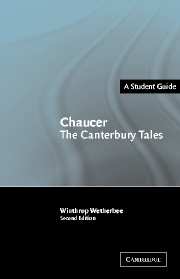Book contents
- Frontmatter
- Contents
- Chronology
- 1 Introduction
- 2 The General Prologue
- 3 Gentles: chivalry and the courtly world
- 4 Churls: commerce and the material world
- 5 Women
- 6 The art and problems of tale-telling
- 7 The final tales
- 8 Afterword: the reception of the Canterbury Tales
- Guide to further reading
- Index to discussions of indivisual tales
6 - The art and problems of tale-telling
Published online by Cambridge University Press: 05 June 2012
- Frontmatter
- Contents
- Chronology
- 1 Introduction
- 2 The General Prologue
- 3 Gentles: chivalry and the courtly world
- 4 Churls: commerce and the material world
- 5 Women
- 6 The art and problems of tale-telling
- 7 The final tales
- 8 Afterword: the reception of the Canterbury Tales
- Guide to further reading
- Index to discussions of indivisual tales
Summary
The Pilgrims' stunned reaction to the Prioress's tale is conveyed in a brief passage that preserves the rhyme-royal stanza of the tale, as if the Prioress's voice were still reverberating in the air. To such a performance there can be no response, and it is fitting that the pilgrim narrator's own tale of Sir Thopas, which follows, is as close as the poem attains to sheer comic relief. The change of tone also marks a broad shift of emphasis. The earlier tales have tended to be dominated by the characters of their tellers. Now the emphasis will be on the nature and effect of the tale itself. Rather than providing surrogates for their narrators, the protagonists of the later tales tend to be broadly comic (Sir Thopas, Chauntecleer), or radically exemplary (Melibee, Cecilie, the Monk's tragic heroes). The techniques and resources of tale-telling become a major concern, inviting us to review and reflect on the diverse strategies of earlier and more ambitious tellers.
The impulse to self-criticism is very strong in Chaucer's poetry, and nowhere more strikingly so than in the paired tales he assigns to his pilgrim narrator. Sir Thopas, in its vacillating movement, its contamination of the idealism of romance with bourgeois vanity and churlish violence, and the haplessness of its narrator in the face of its self-proliferating plot, is a parodic distillation of certain features of the Canterbury Tales as a whole.
- Type
- Chapter
- Information
- Chaucer: The Canterbury Tales , pp. 94 - 110Publisher: Cambridge University PressPrint publication year: 2003



